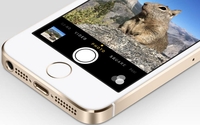 It’s no secret that standalone still and video camera sales have been hit hard by the ability of smartphones to turn us all into amateur paparazzi but recent sales data
indicate they are also cutting deeply into the digital single-lens reflex (DSLR) market populated by pros and advanced amateurs.
It’s no secret that standalone still and video camera sales have been hit hard by the ability of smartphones to turn us all into amateur paparazzi but recent sales data
indicate they are also cutting deeply into the digital single-lens reflex (DSLR) market populated by pros and advanced amateurs.
“Nikon
Corp. cut its full-year unit sales forecast for high-end cameras for the second quarter in a row [Nov. 7], as a dramatic fall in demand among photography hobbyists that began last year accelerated
faster than expected,” Reuters’ Sophie Knight reported last week.
And last month Canon issued a profit warning for the business year ending Dec. 31, citing “economic weakness and worsening consumer sentiment.”
The Wall Street Journal’s Hiroyuki Kachi reported it cut “its outlook for sales of interchangeable-lens cameras to 8
million, or 44% of the global market, from 9 million in the July outlook.”
advertisement
advertisement
CFO Toshizo Tanaka maintained “the recent sales weakness
is ‘only a temporary phenomenon,’” but that may be wishful thinking.
The Wall Street Journal’s Farhad Manjoo pointed out Sunday that “smartphone cameras traditionally have been better in theory than
reality,” with shutter lag and “DMV-like photo quality.” But the iPhone 5s is a game-changer, he feels, with its “burst mode,” low-light capabilities and ability to edit
and share the photos on the Internet. Other manufacturers will, of course, catch up.
(Ad Age this week asked some “expert snappers” how they take “really great pictures” with their
mobile devices. The answers range from framing the shot to finding good light to which editing apps to use to how to create a following on Instagram.)
But the unsettling point of Manjoo’s piece is that “the iPhone 5s's triumph over the camera offers a lesson in how smartphones and tablets will co-opt most other devices in our
lives, from PCs to videogame systems to even our wallets and our keys.”
Despite the well-charted woes of Apple maps when it first launched on the iPhone, for example, one wonders why anyone would buy a GPS System nowadays
with apps readliy available for free on every mobile OS. And yet it was not so long ago that a GPS seemed to be on every driver’s wish list (unless they’d heard too many tales of being
routed to New Jersey to get to Manhattan from Westchester).
“Garmin was once one of the world’s hottest growth
companies—‘the next Apple,’ according to some stock pickers,” Jessica Leber wrote earlier this year in MIT Technology Review. “In 2007 the company, the
world’s top seller of GPS devices for car dashboards and boat cockpits, doubled its sales on what seemed like unquenchable consumer demand for its location-finding gadgets.
“Then,” she observed, “smartphones happened.” But Garmin has been “[fighting] a successful rear-guard action by grabbing
business from other GPS firms, launching top-shelf products for sportsmen and sailors, and diversifying.”
The company’s third
quarter automotive/mobile sales were down 16% from last year, ZDNet’s Larry Dignan reported recently, but it is decidedly a “tale of two companies.” Sales of
Garmin’s fitness products were up 25% during the same period.
But that surge is facing renewed competition. “The M7 chip built into
the iPhone 5s adds some sophisticated fitness tracking features to Apple's newest flagship phone,” as the hed on an analysis of the health tracker market by CNet’s Brian Bennett tells us. But he’s
more inclined to think the probable launch of an iWatch in 2014 is more of a threat to the existing Fitbits, Withings and Jawbones than the bulky phones.
As one commenter to the story points out, “I can't use a phone to replace my Garmin watch for running. The comfort of the watch wins. The price of the watch wins. The
durability of the watch wins. And the convenience of the watch wins.”
For now, at any rate.
Meanwhile, two soon-to-be-released, long-anticipated game consoles — PlayStation 4 from Sony (available tomorrow)
and the Xbox One from Microsoft (being guarded by sharks at the SEA LIFE Aquarium in Auckland, NZ prior to its release Nov. 21) — “will enter a landscape reshaped by tablets, smartphones and Facebook, all of
which provide games at a lower price and in greater abundance,” Nick Wingfield wrote in the New York Times Tuesday.
For serious gamers, of course, there’s no comparison between a hi-def retina display and the thumping sounds and out-sized images of games played on HDTVs, anymore than a boomer would want to watch “Gravity” on an iPhone.
Besides, points out Jack
Tretton, president and CEO of Sony’s United States games division, there’s an upside to mobile devices in his market. “There are people who would never envision playing a game in
years past who have now gotten into it because of smartphones and tablets,” he tells Wingfield.
And “even if mobile games
continue to eat into the overall share of the business held by consoles, the new systems could still be big hits,” former Electronic Arts CEO John Riccitiello indicates to Wingfield.
“There might be a big enough pie for everyone to win,” he maintains.
If only every marketing pie were so large and accommodating, right?